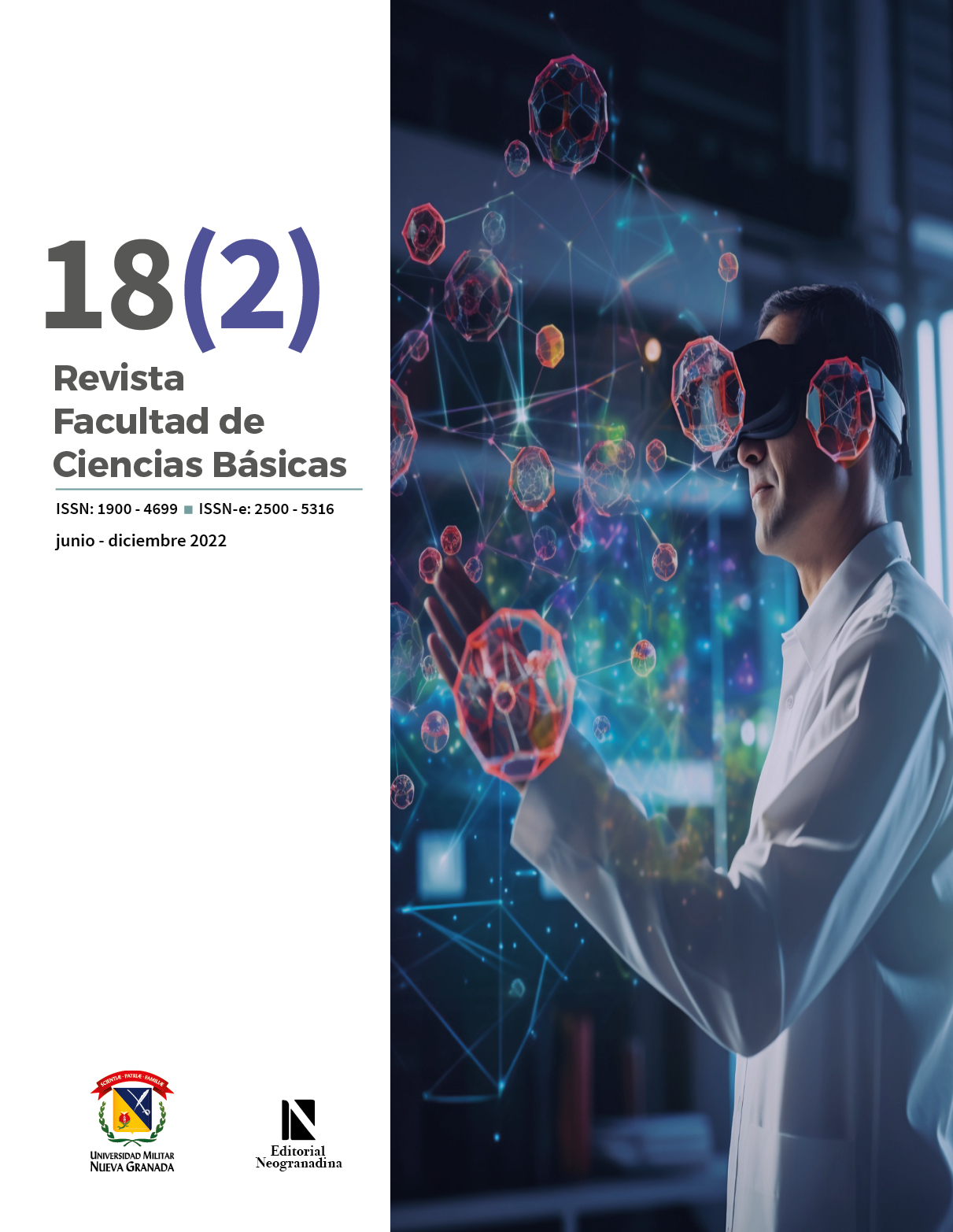Evaluation of the Xtb semiempirical method for the prediction of antioxidant properties in Alzheimer’s Disease: salen-type ligands
Resumen
Alzheimer’s disease (AD) stands as the predominant form of dementia, accounting for up to 70% of all cases worldwide. AD is a complex disease with various contributing factors. Evidence suggests that the metallic complexes formed by the β-amyloid peptide (Aβ) and extraneuronal copper can catalyze the generation of reactive oxygen species, consequently increasing oxidative stress and contributing to the decline of neurons. This interaction underscores the significance of bioavailable copper as a crucial redox-active target in exploring protocols for multifunctional agents in AD treatment. In the field of computational chemistry, density functional theory (DFT) is widely accepted as a standard method across different disciplines. Despite this, DFT presents computational challenges, particularly in screening extensive molecular sets during the initial phases of drug research. Recent advances in semiempirical quantum mechanical methods (SQM) offer a promising alternative, providing rapid molecular geometry optimization and approximate estimation of thermodynamical properties, being at least two orders of magnitude faster than traditional DFT calculations. In this work, we present an evaluation of the GFNn-xTB SQM methods in the rapid screening of antioxidant properties in AD, performed on a set of salen ligands by calculating the standard reduction potentials of their copper complexes as key property. Results show that the implementation of GFNn-xTB SQM calculations before DFT evaluations is a useful technique to expedite the process and save computational time without sacrificing chemical accuracy.
Descargas
Referencias bibliográficas
World Health Organization, “Dementia.” Accessed: Jan. 24, 2024. [Online]. Available: https://www.who.int/es/news-room/fact-sheets/detail/dementia
N. Puentes-Díaz, D. Chaparro, D. Morales-Morales, A. Flores-Gaspar, and J. Alí-Torres, “Role of Metal Cations of Copper, Iron, and Aluminum and Multifunctional Ligands in Alzheimer’s Disease: Experimental and Computational Insights,” ACS Omega, Jan. 2023, https://pubs.acs.org/doi/10.1021/acsomega.2c06939
N. Puentes-Díaz, D. Chaparro, V. Reyes-Marquez, D. Morales-Morales, A. Flores-Gaspar, and J. Alí-Torres, “Computational Evaluation of the Potential Pharmacological Activity of Salen-Type Ligands in Alzheimer’s Disease. - Abstract - Europe PMC.” [Online], Jul. 2023. Available: https://europepmc.org/article/med/37483007
S. Lee et al., “Rational design of a structural framework with potential use to develop chemical reagents that target and modulate multiple facets of Alzheimer’s disease,” J Am Chem Soc, vol. 136, no. 1, pp. 299–310, Jan. 2014, https://pubs.acs.org/doi/10.1021/ja409801p
K. Pradhan et al., “Rhodamine-Based Metal Chelator: A Potent Inhibitor of Metal-Catalyzed Amyloid Toxicity,” ACS Omega, vol. 5, no. 30, pp. 18958–18967, Jul. 2020, https://www.academia.edu/84987536/Rhodamine_Based_Metal_Chelator_A_Potent_Inhibitor_of_Metal_Catalyzed_Amyloid_Toxicity
W. Zhang, J. Pei, and L. Lai, “Computational Multitarget Drug Design,” J Chem Inf Model, vol. 57, no. 3, pp. 403–412, Feb. 2017, https://www.sciencedirect.com/science/article/abs/pii/B9780323897754000109?via%3Dihub
T. Van Mourik, M. Bühl, and M. P. Gaigeot, “Density functional theory across chemistry, physics and biology,” Philos Trans A Math Phys Eng Sci, vol. 372, no. 2011, Mar. 2014, https://www.researchgate.net/publication/260154675_Density_functional_theory_across_chemistry_physics_and_biology_Introduction
S. Grimme, C. Bannwarth, and P. Shushkov, “A Robust and Accurate Tight-Binding Quantum Chemical Method for Structures, Vibrational Frequencies, and Noncovalent Interactions of Large Molecular Systems Parametrized for All spd-Block Elements (Z = 1-86),” J Chem Theory Comput, vol. 13, no. 5, pp. 1989–2009, May 2017, https://pubs.acs.org/doi/10.1021/acs.jctc.7b00118
C. Bannwarth et al., “Extended tight-binding quantum chemistry methods,” Wiley Interdisciplinary Reviews: Computational Molecular Science, vol.11, no 2. Blackwell Publishing Inc.,Mar. 01, 2021. https://wires.onlinelibrary.wiley.com/doi/10.1002/wcms.1493
“Semiempirical Extended Tight-Binding Program Package xtb,” https://github.com/grimme-lab/xtb
S. Ehlert, M. Stahn, S. Spicher, and S. Grimme, “Robust and Efficient Implicit Solvation Model for Fast Semiempirical Methods,” J Chem Theory Comput, vol. 17, no. 7, pp. 4250–4261, Jun. 2021, https://pubs.acs.org/doi/10.1021/acs.jctc.1c00471
“Calculate Root-mean-square deviation (RMSD) of Two Molecules Using Rotation,” GitHub, https://github.com/charnley/rmsd, Version 1.5.1.
W. Kabsch, “A solution for the best rotation to relate two sets of vectors,” Acta Crystallographica Section A, vol. 32, no. 5, pp. 922–923, Sep. 1976, https://www.scienceopen.com/document?vid=5758c8be-538c-4946-91cc-f9f2267dc89b
D. Chaparro and J. Alí-Torres, “Assessment of the isodesmic method in the calculation of standard reduction potential of copper complexes,” J Mol Model, vol. 23, no. 10, Oct. 2017, https://link.springer.com/journal/894/volumes-and-issues/23-10
D. D. Wagman et al., “Erratum: The NBS tables of chemical thermodynamic properties. Selected values for inorganic and C1 and C2 organic substances in SI units [J. Phys. Chem. Ref. Data 11, Suppl. 2 (1982)],” J Phys Chem Ref Data, vol. 18, no. 4, pp. 1807–1812, Oct. 1989, https://nvlpubs.nist.gov/nistpubs/jres/125/jres.125.007.pdf
J. Alí-Torres, A. Mirats, J. D. Maréchal, L. Rodríguez-Santiago, and M. Sodupe, “3D structures and redox potentials of Cu2+-Aβ(1-16) complexes at different pH: A computational study,” Journal of Physical Chemistry B, vol. 118, no. 18, pp. 4840–4850, May 2014, https://pubs.acs.org/doi/10.1021/jp5019718
J. Alí-Torres, A. Mirats, J. D. Maréchal, L. Rodríguez-Santiago, and M. Sodupe, “Modeling Cu2+-Aβ complexes from computational approaches,” AIP Adv, vol. 5, no. 9, p. 92402, Sep. 2015, https://link.springer.com/book/10.1007/978-3-319-00560-7
A. L. Orjuela, F. Núñez-Zarur, and J. Alí-Torres, “A computational protocol for the calculation of the standard reduction potential of iron complexes: application to Fe2+/3+-Aβ model systems relevant to Alzheimer’s disease,” RSC Adv, vol. 12, no. 37, pp. 24077–24087, Aug. 2022, https://pubs.rsc.org/en/content/articlelanding/2022/ra/d2ra03907a
R. R. Conry, “Copper: Inorganic & Coordination Chemistry Based in part on the article Copper: Inorganic & Coordination Chemistry by Rebecca R. Conry & Kenneth D. Karlin which appeared in the Encyclopedia of Inorganic Chemistry, First Edition.,” Encyclopedia of Inorganic Chemistry, Sep. 2005, https://onlinelibrary.wiley.com/doi/10.1002/0470862106.ia052
David L. Nelson. and Michael M. Cox, Lehninger - Principles of Biochemistry, Sexta Edición. New York: W.H. Freeman And Company, 2013. [Online]. Availablehttps://search.worldcat.org/es/title/Lehninger-principles-of-biochemistry/oclc/824794893
H. Neugebauer, F. Bohle, M. Bursch, A. Hansen, and S. Grimme, “Benchmark Study of Electrochemical Redox Potentials Calculated with Semiempirical and DFT Methods,” J Phys Chem A, vol. 124, no. 35, pp. 7166–7176, Aug. 2020, https://pubs.acs.org/doi/10.1021/acs.jpca.0c05052
C. Bannwarth, S. Ehlert, and S. Grimme, “GFN2-xTB - An Accurate and Broadly Parametrized Self-Consistent Tight-Binding Quantum Chemical Method with Multipole Electrostatics and Density-Dependent Dispersion Contributions,” J Chem Theory Comput, vol. 15, no. 3, pp. 1652–1671, Mar. 2019, https://pubs.acs.org/doi/10.1021/acs.jctc.8b01176
A. V. Onufriev and D. A. Case, “Generalized Born Implicit Solvent Models for Biomolecules,” Annu Rev Biophys, vol. 48, pp. 275–296, May 2019, https://www.annualreviews.org/content/journals/10.1146/annurev-biophys-052118-115325
Gorges, S. Grimme, and A. Hansen, “Reliable prediction of association (free) energies of supramolecular complexes with heavy main group elements – the HS13L benchmark set,” Physical Chemistry Chemical Physics, vol. 24, no. 47, pp. 28831–28843, Dec. 2022, https://pubs.rsc.org/en/content/articlelanding/2022/cp/d2cp04049b
M. Isegawa, F. Neese, and D. A. Pantazis, “Ionization Energies and Aqueous Redox Potentials of Organic Molecules: Comparison of DFT, Correlated ab Initio Theory and Pair Natural Orbital Approaches,” J Chem Theory Comput, vol. 12, no. 5, pp. 2272–2284, Apr. 2016, https://www.mdpi.com/1420-3049/22/4/577

Datos de los fondos
-
Dirección de Investigación, Universidad Nacional de Colombia
Números de la subvención 57465
Derechos de autor 2024 Revista Facultad de Ciencias Básicas

Esta obra está bajo una licencia internacional Creative Commons Atribución-NoComercial-SinDerivadas 4.0.











